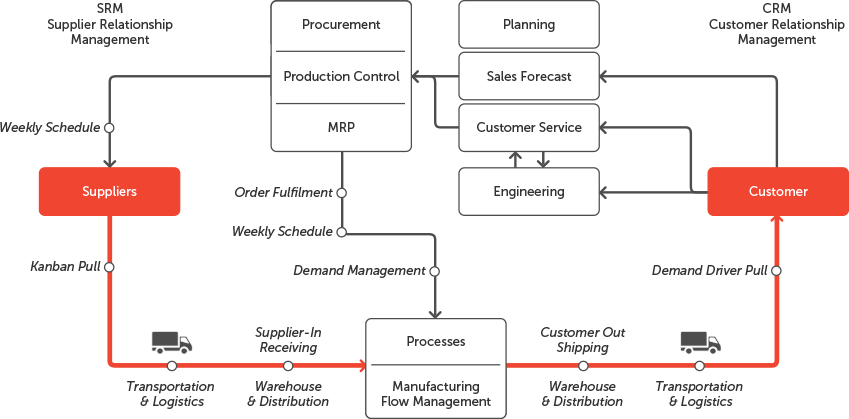Introduction
In today’s rapidly evolving world, the pursuit of sustainability has become a paramount concern across industries. Nowhere is this more apparent than in the field of materials and manufacturing processes. As we grapple with environmental challenges, the need for sustainable practices in materials sourcing and production has never been more pressing. In this article, we will explore the vital intersection of sustainable materials and manufacturing processes, examining the innovations and initiatives that are reshaping the landscape of industry while reducing its ecological footprint.
The imperative of sustainability has permeated every corner of our modern world, bringing about a profound transformation across industries. Nowhere is this transformation more pronounced than in the realms of materials and manufacturing processes. As we confront pressing environmental issues, the call for sustainable practices in both materials sourcing and production has never resonated more urgently.
Resource Efficiency: Sustainable materials and manufacturing practices prioritize resource efficiency. They aim to extract the maximum utility from every resource, minimizing waste and reducing the strain on finite resources. This approach not only conserves natural resources but also contributes to cost savings for businesses.
Circular Economy: The concept of a circular economy, where materials are reused, recycled, or repurposed at the end of their life cycle, has gained traction. Sustainable materials and manufacturing processes embrace this approach, reducing the demand for new resources and minimizing landfill waste.
Renewable Materials: Sourcing materials from renewable sources, such as sustainably managed forests for wood products or agricultural waste for bioplastics, is a hallmark of sustainability. These materials can be replenished, reducing the environmental impact associated with extraction.
Reduced Carbon Footprint: Sustainable manufacturing processes often prioritize energy efficiency and emissions reduction. This translates into lower carbon footprints for products, contributing to climate change mitigation efforts.
Eco-Friendly Innovations: Innovation in sustainable materials and manufacturing has given rise to remarkable eco-friendly materials. For example, researchers are developing biodegradable plastics, advanced composite materials, and energy-efficient manufacturing techniques that significantly reduce environmental harm.
Local Sourcing: Reducing the distance materials travel before reaching the manufacturing facility is another sustainable practice. Local sourcing minimizes transportation-related emissions and supports regional economies.
Life Cycle Assessment: Manufacturers are increasingly conducting life cycle assessments to evaluate the environmental impact of their products from cradle to grave. This holistic approach identifies areas for improvement and informs sustainable design choices.
Regulatory Compliance: Governments worldwide are implementing stringent regulations and standards related to sustainability. Companies that embrace sustainable materials and manufacturing processes not only comply with these regulations but also gain a competitive edge by demonstrating environmental responsibility.
Consumer Preferences: Consumers are increasingly favoring products made with sustainable materials and processes. This shift in consumer preferences is pushing industries to adopt sustainability as a core tenet, promoting the adoption of green practices.
Collaboration and Transparency: Sustainability initiatives often involve collaboration among industry stakeholders, including manufacturers, suppliers, and consumers. Transparency in the supply chain, from raw materials to end products, is essential to ensure sustainable practices are upheld.
Sustainable Design: Sustainable materials and manufacturing processes are intertwined with sustainable product design. Companies are rethinking product design to optimize materials use, durability, and end-of-life considerations.
Sustainability as a Competitive Advantage: Sustainability is no longer just an ethical choice but also a strategic one. Companies that prioritize sustainability are often more resilient, attract eco-conscious consumers, and enjoy a competitive advantage in a rapidly changing business landscape.
In this era of environmental awakening, the pursuit of sustainability in materials and manufacturing is reshaping industries, fostering innovation, and inspiring a global commitment to protecting our planet. As we explore the evolving landscape of sustainable practices, we uncover a promising future where industry and ecology coexist harmoniously, driving positive change for generations to come.
If you’d like to dive deeper into this subject, there’s more to discover on this page: Understanding the adoption of Industry 4.0 technologies in …
Traditional manufacturing processes often entail resource depletion, emissions, and pollution. The adoption of sustainable materials and practices is a response to these environmental challenges. Sustainable materials are sourced, produced, and disposed of in ways that minimize harm to ecosystems and reduce waste.
The transition from traditional manufacturing to sustainable practices represents a fundamental shift in the way we produce goods and manage resources. This evolution not only addresses environmental challenges but also has profound implications for various aspects of industry and society:
Resource Conservation: Sustainable manufacturing focuses on resource efficiency, aiming to minimize resource depletion. This entails the careful management of raw materials, the reduction of waste in production processes, and the recycling or repurposing of materials whenever possible. As a result, industries are becoming less reliant on finite resources and more inclined toward a circular economy.
Emissions Reduction: Traditional manufacturing often contributes to greenhouse gas emissions and air pollution. Sustainable practices prioritize low-carbon and clean energy sources, such as solar and wind power. This transition results in reduced emissions, cleaner air, and a smaller carbon footprint.
Improved Energy Efficiency: Sustainable manufacturing places a premium on energy efficiency. By adopting energy-efficient technologies and processes, industries can significantly reduce energy consumption, leading to cost savings and a decreased environmental impact. These efforts align with global energy conservation goals.
Waste Minimization: Sustainable manufacturing reduces waste generation through various means, including lean production techniques and waste reduction strategies. This not only conserves resources but also minimizes the environmental impact of landfills and incineration.
Economic Benefits: The adoption of sustainable materials and practices can yield economic advantages. Companies that embrace sustainability often enjoy cost savings through reduced resource consumption, energy efficiency, and improved public relations, attracting eco-conscious consumers and investors.
Eco-Friendly Materials: Sustainable materials are sourced responsibly, often with an emphasis on renewable resources and eco-friendly production methods. Bamboo, recycled plastics, and reclaimed wood are examples of materials used in sustainable manufacturing. These materials not only reduce environmental harm but also provide unique properties and aesthetics.
Supply Chain Transparency: Sustainability has pushed for greater transparency in supply chains. Manufacturers are increasingly held accountable for the environmental and social impact of their entire production process, from raw material extraction to product disposal. This transparency empowers consumers to make more informed choices.
Regulatory Compliance: Governments worldwide are enacting stricter environmental regulations. Manufacturers that adopt sustainable practices are more likely to comply with these regulations, avoiding fines and legal issues associated with non-compliance.
Consumer Demand: As environmental awareness grows, consumers are increasingly seeking products and brands that align with their values. Sustainable manufacturing responds to this demand by offering eco-friendly products that cater to a conscientious consumer base.
Technological Innovation: Sustainable manufacturing fosters innovation in materials and processes. Researchers and engineers are constantly developing new materials and methods that reduce environmental impact, stimulate economic growth, and open up new avenues for sustainable production.
In conclusion, the shift toward sustainable manufacturing represents a holistic approach to mitigating environmental harm, conserving resources, and building a more resilient and responsible industrial landscape. This transformation is not only necessary for addressing pressing environmental challenges but also offers economic, social, and ethical benefits that extend far beyond the factory floor.
Additionally, you can find further information on this topic by visiting this page: Sustainable Manufacturing | US EPA

The responsible use of resources is a key component of sustainability. Sustainable materials may involve the use of renewable resources, recycled content, or materials with a smaller ecological footprint. This approach helps conserve valuable resources for future generations.
The responsible use of resources is an indispensable pillar of sustainability, encompassing a range of practices and considerations that extend well beyond the concept of conservation alone. Within this framework, sustainable materials take center stage, as they offer multifaceted benefits for both the present and future. Here’s a more comprehensive exploration of the significance of sustainable materials and their role in preserving resources for generations to come:
Renewable Resources: A cornerstone of sustainable materials is the utilization of renewable resources. These are resources that can be naturally replenished over time, such as bamboo, cork, or fast-growing timber. By opting for materials derived from renewable sources, we reduce our dependence on finite resources like fossil fuels and virgin timber, which are often environmentally costly to extract and process.
Recycled Content: Incorporating recycled content into materials and products represents a substantial leap toward resource conservation. By reusing materials like plastics, metals, and paper, we not only divert waste from landfills but also decrease the need for virgin resources. This practice significantly lessens the environmental impact of manufacturing processes.
Reduced Ecological Footprint: Sustainable materials often possess a smaller ecological footprint, meaning they have lower energy and resource requirements throughout their life cycle. For instance, the production of certain sustainable building materials generates fewer greenhouse gas emissions, consumes less water, and minimizes energy consumption compared to conventional alternatives.
Enhanced Resource Efficiency: The use of sustainable materials is inherently resource-efficient. These materials are designed to maximize utility while minimizing waste. This approach contributes to efficient resource allocation and utilization, making the most of what is available and reducing resource depletion.
Preservation of Biodiversity: Sustainable materials consider the impact on biodiversity. For instance, responsible harvesting of timber involves practices that maintain forest ecosystems, prevent deforestation, and protect endangered species. These efforts help preserve vital habitats for future generations.
Longevity and Durability: Sustainable materials are often chosen for their durability and longevity. They are designed to withstand wear and tear, reducing the need for frequent replacement and minimizing the resources required for maintenance and repair over time.
Consumer Awareness and Choice: The adoption of sustainable materials is closely tied to consumer preferences. As more individuals and businesses prioritize sustainability, manufacturers are responding by offering eco-friendly products and materials. This shift in consumer awareness and choice drives the demand for sustainable options, furthering the cause of resource conservation.
Regulatory Incentives: Governments and regulatory bodies are increasingly incentivizing the use of sustainable materials through policies, certifications, and tax incentives. These measures encourage industries to adopt sustainable practices and materials, ultimately benefiting the environment and society.
Circular Economy: Sustainable materials contribute to the development of a circular economy. In this model, products and materials are designed for reuse, refurbishment, and recycling. This approach reduces waste generation and extends the life cycle of resources, aligning with sustainability goals.
Future Generations: Ultimately, the responsible use of resources and the adoption of sustainable materials are an investment in the well-being of future generations. By preserving resources today, we ensure that our descendants have access to the raw materials and ecosystems necessary for their own prosperity and quality of life.
In summary, the commitment to sustainable materials is a fundamental element of responsible resource management. It goes beyond mere conservation, encompassing the utilization of renewable sources, the incorporation of recycled content, and the promotion of resource-efficient practices. By prioritizing sustainable materials, we contribute to a more sustainable and equitable future, where valuable resources are safeguarded and made available for generations to come.
To delve further into this matter, we encourage you to check out the additional resources provided here: News Flash • Pitkin County, CO • CivicEngage

Sustainable manufacturing processes prioritize energy efficiency. Energy-intensive industries are exploring renewable energy sources, implementing energy-saving technologies, and reevaluating production methods to reduce their energy consumption.
Sustainable manufacturing processes, with their focus on energy efficiency, are driving a significant shift in how industries operate and are poised to make substantial contributions to environmental conservation and cost savings. Expanding on this idea, let’s delve deeper into the measures and strategies employed by energy-intensive industries to achieve greater sustainability:
Renewable Energy Integration: Many energy-intensive industries are transitioning to renewable energy sources, such as wind, solar, and hydropower, to power their operations. By harnessing clean, renewable energy, these industries not only reduce their carbon footprint but also insulate themselves from the volatility of fossil fuel prices. Installing solar panels or wind turbines on-site or sourcing renewable energy from off-site providers is becoming increasingly common.
Energy-Efficient Technologies: Sustainable manufacturing involves the adoption of state-of-the-art energy-efficient technologies. These technologies encompass a wide range of improvements, from advanced heating, ventilation, and air conditioning (HVAC) systems to the utilization of LED lighting and intelligent energy management systems. Such upgrades help minimize energy wastage and optimize consumption, leading to substantial energy savings.
Process Optimization: Manufacturers are reevaluating and reengineering their production processes to make them more energy-efficient. This often involves redesigning equipment, optimizing workflows, and utilizing advanced automation and control systems to ensure that energy is used judiciously at every step. Such process optimization not only conserves energy but also improves overall production efficiency.
Waste Heat Recovery: Energy-intensive industries, particularly those with high-temperature processes, are increasingly incorporating waste heat recovery systems. These systems capture and reuse heat that would otherwise be lost into the environment. By repurposing this thermal energy for various processes, manufacturers reduce their reliance on additional energy sources and lower operational costs.
Carbon Capture and Storage (CCS): In sectors where decarbonization is challenging, such as heavy manufacturing and cement production, carbon capture and storage technologies are being explored. CCS captures carbon dioxide emissions before they are released into the atmosphere and stores them underground. This not only reduces greenhouse gas emissions but also aligns with carbon neutrality goals.
Energy Management Systems (EMS): Advanced energy management systems are pivotal in sustainable manufacturing. These systems provide real-time monitoring and control of energy use across the production facility. They enable manufacturers to pinpoint areas of inefficiency, adjust equipment settings, and even schedule energy-intensive processes during off-peak times, optimizing energy utilization.
Employee Training and Engagement: Sustainability efforts in energy-intensive industries are not solely dependent on technology. Employee training and engagement play a critical role in energy conservation. By fostering a culture of sustainability and providing workers with the knowledge and tools to identify energy-saving opportunities, companies can harness the collective effort of their workforce to achieve energy efficiency goals.
Life Cycle Assessments: Manufacturers are conducting comprehensive life cycle assessments (LCAs) to evaluate the environmental impact of their products and processes. LCAs consider the entire lifecycle, from raw material extraction to product disposal. This holistic view helps identify areas where energy use can be reduced and emissions minimized.
In conclusion, sustainable manufacturing processes are driving the transformation of energy-intensive industries, making them more environmentally responsible and economically viable. The adoption of renewable energy, the integration of energy-efficient technologies, process optimization, and the implementation of waste heat recovery systems are all part of a multifaceted approach to achieving energy efficiency. These efforts not only reduce energy consumption and greenhouse gas emissions but also position industries to thrive in an era where sustainability is an increasingly critical factor for success. By embracing these sustainable practices, energy-intensive sectors are not just conserving energy but also ensuring a more sustainable and resilient future for themselves and the planet.
For additional details, consider exploring the related content available here Next Generation Materials and Processes | Department of Energy

Sustainable practices aim to minimize waste generation. This includes reducing scrap and optimizing production to use raw materials more efficiently. By doing so, manufacturers not only reduce disposal costs but also contribute to a circular economy.
Sustainable practices are fundamentally about reimagining our approach to resource utilization and waste management. Going beyond the immediate benefits of waste reduction and cost savings, they lay the foundation for a circular economy, where resources are conserved and reused to minimize environmental impact. Let’s explore this idea further:
Resource Efficiency: Sustainable practices prioritize resource efficiency throughout the production process. This involves not only reducing waste but also optimizing the use of raw materials, energy, and water. Manufacturers adopt technologies and processes that minimize resource consumption, thereby lowering production costs and conserving valuable resources for the future.
Circular Economy Principles: The concept of a circular economy is central to sustainability. Rather than following a linear “take, make, dispose” model, a circular economy seeks to close the loop by reusing, remanufacturing, and recycling materials. By reducing waste generation and reusing materials, manufacturers actively contribute to this circular approach, reducing the need for virgin resources and mitigating environmental degradation.
Economic Benefits: Beyond environmental considerations, sustainability offers compelling economic benefits. Reduced waste generation results in lower disposal costs, which can be a significant expense for manufacturers. By minimizing waste, companies can redirect resources toward innovation, product development, and growth.
Reduced Environmental Impact: Sustainable practices align with broader environmental goals, such as reducing carbon emissions and conserving natural habitats. By producing less waste and optimizing resource use, manufacturers reduce their environmental footprint, contributing to the mitigation of climate change and the preservation of ecosystems.
Product Life Extension: In addition to optimizing production processes, sustainability extends to the entire lifecycle of products. Manufacturers are increasingly designing products with durability and repairability in mind, enabling consumers to use products for longer periods and reducing the need for frequent replacements.
Consumer Preferences: Today’s consumers are increasingly environmentally conscious, and they favor products and brands that demonstrate a commitment to sustainability. Manufacturers that embrace sustainable practices not only meet consumer expectations but also enhance their brand image and market competitiveness.
Regulatory Compliance: Many regions have implemented environmental regulations that encourage or mandate sustainable practices. Compliance with these regulations is essential for manufacturers to avoid penalties and maintain their operations. Embracing sustainability proactively helps companies stay ahead of regulatory changes.
Innovation and Collaboration: Sustainability drives innovation by pushing manufacturers to find creative solutions to reduce waste and improve resource efficiency. It also fosters collaboration across industries as companies seek to share best practices, develop eco-friendly technologies, and collectively address global environmental challenges.
Long-term Resilience: Sustainability contributes to the long-term resilience of manufacturers. By reducing dependency on finite resources and minimizing waste, companies become better prepared to weather resource scarcity, market fluctuations, and other challenges that may arise in the future.
In summary, sustainable practices in waste reduction and resource optimization are not merely about minimizing costs; they represent a pivotal shift toward a circular economy and a more environmentally responsible future. Manufacturers that embrace sustainability not only reduce their environmental impact but also position themselves for economic success, consumer trust, and long-term resilience in an ever-changing global landscape.
You can also read more about this here: Sustainability 4.0 and its applications in the field of manufacturing …

Sustainable materials and processes undergo a comprehensive lifecycle assessment. This entails analyzing their impact from raw material extraction to disposal. Manufacturers seek to identify and address environmental hotspots throughout the product’s lifecycle.
Sustainable materials and processes are at the forefront of responsible manufacturing practices, and they undergo rigorous scrutiny through a comprehensive lifecycle assessment (LCA). This holistic approach is fundamental to understanding the true environmental impact of a product or process, enabling manufacturers to make informed decisions that prioritize sustainability at every stage.
Raw Material Extraction: The journey towards sustainability begins with a close examination of raw material extraction. This includes assessing the environmental consequences of mining, logging, or harvesting materials. Sustainable practices involve choosing materials with lower environmental footprints, exploring renewable sources, and adopting responsible extraction techniques that minimize habitat disruption and resource depletion.
Manufacturing and Production: The manufacturing phase is often a critical juncture for environmental impact. Sustainable manufacturing focuses on minimizing energy consumption, reducing waste, and employing eco-friendly production methods. Innovations like 3D printing and lean manufacturing techniques have enabled more efficient use of materials, reducing both costs and environmental burdens.
Transport and Distribution: The environmental impact continues as products are transported to consumers. Sustainable transportation strategies, such as optimizing supply chains, utilizing electric or hybrid vehicles, and minimizing packaging waste, all play pivotal roles in reducing the carbon footprint associated with the distribution of goods.
Product Use and Maintenance: Sustainable considerations extend beyond production to the usage phase. Manufacturers increasingly design products for longevity, ease of repair, and energy efficiency. These efforts not only reduce environmental impact but also enhance the value and satisfaction for consumers.
End-of-Life Management: The lifecycle assessment encompasses the final stage: disposal or recycling. Sustainable materials and processes prioritize recyclability and biodegradability, making it easier to divert products from landfills. Additionally, responsible disposal methods, such as electronic waste recycling for electronics, ensure that harmful substances do not leach into the environment.
Identifying Environmental Hotspots: Throughout this comprehensive analysis, manufacturers actively seek out environmental hotspots—areas with the most significant environmental impacts. By pinpointing these hotspots, companies can direct their efforts toward finding innovative solutions and sustainable alternatives. For example, if the extraction of a specific raw material is causing substantial harm, manufacturers might explore alternative materials or more responsible sourcing practices.
Continuous Improvement: The lifecycle assessment is an iterative process. Manufacturers continually monitor, measure, and refine their sustainability efforts. This approach ensures that environmental responsibility remains a dynamic, ongoing commitment rather than a one-time endeavor.
In summary, sustainable materials and processes are rooted in a thorough and conscientious assessment of their entire lifecycle. By scrutinizing their environmental impact from raw material extraction to disposal, manufacturers not only minimize harm but actively seek out opportunities for improvement. Through this dedication to sustainability, they contribute to a more responsible and eco-conscious approach to production and consumption, aligning with the growing global commitment to environmental stewardship.
For additional details, consider exploring the related content available here Sustainability Assessment of Aerospace Manufacturing: An LCA …

Industries are increasingly turning to recycled and upcycled materials as sustainable alternatives. This includes recycled plastics, metals, glass, and textiles, which reduce the demand for virgin resources and alleviate waste management challenges.
Industries are increasingly turning to recycled and upcycled materials as sustainable alternatives, driven by a growing awareness of the environmental impacts of resource extraction and waste generation. This shift encompasses a wide range of materials, including recycled plastics, metals, glass, and textiles, and it holds profound implications for both business practices and the planet.
Resource Conservation: Using recycled and upcycled materials conserves valuable natural resources. For example, recycling plastic bottles into new plastic products reduces the need for petroleum-based plastics, which are derived from fossil fuels. By doing so, industries can contribute to mitigating the environmental consequences of resource depletion.
Waste Reduction: Recycling diverts materials from landfills and incineration, helping alleviate waste management challenges. As the global population grows and urbanizes, waste disposal becomes an increasingly pressing issue. By incorporating recycled materials into their products and processes, industries can reduce the overall volume of waste generated.
Energy Savings: Manufacturing products from recycled materials often requires less energy compared to producing goods from virgin resources. This energy efficiency contributes to lower greenhouse gas emissions and reduced environmental impact, aligning with sustainability goals.
Circular Economy: The adoption of recycled materials promotes the principles of a circular economy. In this model, materials are reused and repurposed in a closed-loop system, reducing the need for constant extraction and production of new materials. This circular approach is crucial for long-term environmental sustainability.
Consumer Preference: Consumers are increasingly favoring products made from recycled or upcycled materials, reflecting a growing eco-consciousness. Businesses that embrace these materials can appeal to a broader customer base and enhance their brand reputation as environmentally responsible entities.
Innovation Opportunities: The use of recycled materials drives innovation in material science and engineering. Researchers are constantly developing new techniques to process and transform recycled materials into high-quality products, opening up exciting opportunities for technological advancement.
Regulatory Compliance: Environmental regulations and standards are becoming more stringent, requiring businesses to reduce their environmental footprint. Incorporating recycled materials into their operations can help companies comply with these regulations and avoid potential penalties.
Collaboration Across Industries: The recycling and upcycling movement often involves collaboration across industries. For instance, the fashion industry collaborates with the textile recycling sector to reduce textile waste, while the automotive industry seeks sustainable solutions for recycling vehicle components. These cross-industry partnerships drive holistic sustainability efforts.
In essence, the adoption of recycled and upcycled materials represents a pivotal step toward a more sustainable future. It not only addresses resource scarcity and waste management challenges but also aligns with consumer preferences and regulatory requirements. As industries increasingly embrace these materials, they contribute to a global shift toward more responsible and environmentally conscious production practices, making significant strides toward a greener and more sustainable world.
To expand your knowledge on this subject, make sure to read on at this location: Innovation

Biodegradable materials are designed to break down naturally, reducing the environmental burden of long-lasting products. Examples include biodegradable plastics and packaging materials made from organic compounds.
Biodegradable materials represent a significant leap forward in sustainable product design and environmental responsibility. These materials are engineered with a fundamental objective: to reduce the ecological footprint of products by ensuring that they can naturally decompose and reintegrate into the environment, rather than persisting as long-lasting waste. Here, we delve deeper into the world of biodegradable materials and explore their broader applications beyond plastics and packaging:
Diverse Material Range: While biodegradable plastics and packaging materials are some of the most well-known examples, biodegradability extends far beyond this realm. Biodegradable materials encompass a wide spectrum, including textiles, construction materials, and even electronics components. These innovations are unlocking new possibilities for sustainable design across industries.
Environmental Impact Reduction: Biodegradable materials offer a direct solution to the problem of plastic pollution and landfill waste. When disposed of properly, these materials break down into harmless substances, reducing the strain on landfills and curbing the release of harmful chemicals associated with traditional plastics.
Reduced Dependency on Fossil Fuels: Many traditional plastics are derived from fossil fuels. Biodegradable alternatives often use renewable resources such as cornstarch, sugarcane, or hemp. This shift reduces our reliance on non-renewable resources and supports a more sustainable supply chain.
Packaging Innovation: Biodegradable packaging materials are becoming increasingly prevalent. From food containers to shopping bags, these materials offer a responsible alternative to single-use plastics. Innovations like edible packaging and plant-based films provide creative solutions to reduce packaging waste.
Agricultural Applications: Biodegradable materials find applications in agriculture, where mulch films made from biodegradable plastics help improve soil health. These films break down into organic matter, enriching the soil and reducing plastic contamination in farmlands.
Medical and Healthcare: Biodegradable materials are making strides in the medical field. For instance, biodegradable sutures and implants reduce the need for follow-up surgeries to remove non-biodegradable materials. This enhances patient outcomes and reduces medical waste.
Textiles and Apparel: Sustainable fashion is on the rise, thanks in part to biodegradable textiles. Fabrics made from natural fibers like bamboo, hemp, and organic cotton are not only biodegradable but also environmentally friendly throughout their lifecycle.
Construction and Architecture: Biodegradable materials are gaining traction in construction. Products like biodegradable insulation, eco-friendly adhesives, and sustainable building materials contribute to green building practices and reduce the environmental impact of construction projects.
Consumer Electronics: The electronics industry is exploring biodegradable components and materials for products like smartphones and accessories. These materials, when integrated into electronic devices, reduce electronic waste and promote responsible disposal.
Regulatory Support: Governments and regulatory bodies are recognizing the importance of biodegradable materials in environmental conservation. Legislation and standards are being developed to encourage the adoption of biodegradable alternatives and hold manufacturers accountable for sustainable practices.
In essence, the world of biodegradable materials is a realm of innovation and sustainability, offering solutions that span diverse industries and applications. As environmental consciousness grows and the call for responsible consumption intensifies, the development and adoption of biodegradable materials will continue to flourish, shaping a more eco-friendly future for products and industries worldwide.
If you’d like to dive deeper into this subject, there’s more to discover on this page: 10 Eco-Friendly Packaging Alternatives for Your Business’s …

Advanced composites made from sustainable fibers, such as bamboo, flax, or hemp, are gaining prominence in industries like automotive and aerospace. These materials offer impressive strength-to-weight ratios while being eco-friendly.
The rise of advanced composites forged from sustainable fibers like bamboo, flax, and hemp is heralding a new era of materials innovation across various industries, particularly in automotive and aerospace. These sustainable materials represent a compelling synergy of strength, lightweight properties, and eco-consciousness, driving profound changes in manufacturing and design:
Eco-Friendly Manufacturing: One of the standout features of sustainable fiber composites is their environmentally friendly production. Unlike traditional composites reliant on energy-intensive and polluting processes, these materials are cultivated from rapidly renewable resources. The growth of bamboo, flax, and hemp requires fewer chemical inputs, reduces carbon emissions, and promotes soil health.
Reduced Weight and Fuel Efficiency: Sustainable fiber composites are known for their exceptional strength-to-weight ratios. In the automotive sector, their introduction into vehicle components, such as body panels and structural elements, reduces overall weight. This, in turn, enhances fuel efficiency, extending the range of electric vehicles and improving the miles per gallon in combustion engine vehicles.
Enhanced Safety: In aerospace, the lightweight yet robust nature of sustainable composites is reshaping aircraft design. These materials contribute to reduced aircraft weight, enhancing overall fuel efficiency and range. Simultaneously, they maintain structural integrity and safety standards, fostering a new era of sustainable air travel.
Design Flexibility: Sustainable fiber composites offer a high degree of design flexibility. They can be molded into complex shapes and tailored to meet specific performance criteria. This flexibility encourages innovative designs and opens the door to novel applications across industries.
Durability and Longevity: Bamboo, flax, and hemp composites often exhibit impressive durability, with resistance to corrosion and fatigue. This longevity is particularly valuable in industries where components are subjected to harsh environmental conditions and mechanical stress.
Recyclability: Unlike some traditional composite materials that are challenging to recycle, sustainable fiber composites can often be repurposed or recycled at the end of their life cycle. This aligns with the principles of a circular economy, reducing waste and conserving resources.
Renewable Feedstock: The use of renewable feedstock in sustainable composites promotes crop diversification. Farmers can cultivate these crops as rotational crops, improving soil health and reducing the reliance on monoculture farming practices.
Agricultural Sustainability: Sustainable fiber composites support sustainable agricultural practices. The cultivation of bamboo, flax, and hemp requires fewer synthetic pesticides and fertilizers, reducing the environmental impact of agriculture.
Market Expansion: As sustainability becomes a central concern for consumers and businesses alike, the market for sustainable fiber composites is expanding rapidly. This growth is driving investment in research, development, and production capacity, making these materials more accessible and cost-effective.
Cross-Industry Applications: Sustainable fiber composites are not limited to automotive and aerospace but are also finding applications in industries like construction, sports equipment, and consumer goods. This cross-industry versatility is expanding the reach and impact of these materials.
In essence, the adoption of advanced composites made from sustainable fibers reflects a commitment to a more sustainable and environmentally responsible future. These materials embody the intersection of innovation and eco-consciousness, offering a pathway to address critical challenges, from reducing greenhouse gas emissions to conserving resources and fostering resilience in the face of environmental changes. As industries increasingly embrace these materials, we witness a paradigm shift toward a more sustainable and dynamic world of manufacturing and design.
Don’t stop here; you can continue your exploration by following this link for more details: NASA Awardees to Develop Sustainable Aviation Composite Tech …

Nano-materials, engineered at the nanoscale, exhibit unique properties that can enhance product performance while reducing resource consumption. Carbon nanotubes, for instance, are being explored for their potential in various industries.
The realm of nanotechnology, particularly the utilization of nano-materials, introduces a new dimension to product innovation and sustainability. Beyond carbon nanotubes, a myriad of nanomaterials are poised to revolutionize industries, enhancing product performance and sustainability in remarkable ways:
Lightweight and High Strength: Nano-materials, such as carbon nanotubes, possess exceptional strength-to-weight ratios. This makes them invaluable in industries like aerospace, where reducing the weight of components while maintaining strength is crucial for fuel efficiency and performance.
Enhanced Conductivity: Nanomaterials like graphene exhibit exceptional electrical and thermal conductivity. They are poised to play a pivotal role in the development of advanced electronics, energy storage solutions, and even the next generation of flexible and wearable technologies.
Improved Durability: Nano-coatings and reinforcements can significantly enhance the durability and lifespan of products. For instance, nanocomposites in construction materials offer superior resistance to wear, weathering, and corrosion, leading to longer-lasting and more sustainable infrastructure.
Energy Efficiency: Nanomaterials are at the forefront of energy efficiency efforts. They can improve the efficiency of solar panels, energy storage devices, and even energy-efficient lighting systems. This translates into reduced energy consumption and a smaller carbon footprint.
Medical Breakthroughs: Nano-materials are revolutionizing healthcare. They enable targeted drug delivery, highly sensitive diagnostic tools, and innovative tissue engineering solutions. These advancements improve patient care while reducing the need for excessive pharmaceuticals and invasive procedures.
Environmental Remediation: Nanotechnology offers novel approaches to environmental remediation. Nanoparticles can be designed to remove contaminants from water, soil, and air. They hold the potential to mitigate pollution and restore ecosystems more efficiently than traditional methods.
Reduced Material Waste: Nano-engineering can lead to the creation of materials with superior properties, reducing the quantity of raw materials needed for production. This not only conserves resources but also lowers the environmental impact of mining and manufacturing.
Sustainable Packaging: Nanomaterials are playing a role in sustainable packaging solutions. They can enhance the barrier properties of packaging materials, extending the shelf life of food products and reducing food waste.
Water Purification: Nanotechnology is contributing to breakthroughs in water purification. Nanomaterials can effectively remove contaminants, making water treatment more energy-efficient and environmentally friendly.
Space Exploration: Nanomaterials are of interest to space agencies for their potential to enhance spacecraft and equipment. Lightweight, strong materials are essential for reducing launch costs and improving mission efficiency.
However, the adoption of nanomaterials is not without challenges. Concerns related to toxicity, environmental impact, and ethical considerations must be carefully addressed. Regulation and oversight are essential to ensure the responsible development and application of nanotechnology.
In summary, nano-materials represent a powerful tool in the pursuit of product performance enhancement and resource conservation. Their unique properties and versatile applications across various industries hold the promise of a more sustainable and innovative future, provided that ethical and environmental considerations remain at the forefront of their development and use.
If you’d like to dive deeper into this subject, there’s more to discover on this page: Sustainable Materials and Chemical Processes for Additive …

Lean manufacturing principles prioritize the elimination of waste in production processes. By minimizing overproduction, reducing defects, and optimizing resource use, manufacturers can significantly enhance sustainability.
Lean manufacturing principles represent a paradigm shift in how industries approach production processes. These principles not only improve efficiency and reduce costs but also align seamlessly with sustainability goals, fostering a more responsible and eco-conscious approach to manufacturing. Let’s delve deeper into how lean manufacturing contributes to sustainability and resource conservation:
Waste Minimization: At the heart of lean manufacturing is the relentless pursuit of waste elimination. By identifying and eliminating waste in various forms, such as excess materials, unnecessary processes, or idle time, manufacturers significantly reduce their resource consumption. This includes both raw materials and energy resources, leading to a more sustainable production process.
Just-in-Time Production: Lean manufacturing promotes the just-in-time (JIT) production model, which entails producing only what is needed when it is needed. This approach minimizes excess inventory, reducing the storage space required and the potential for waste due to obsolete or spoiling materials. JIT also cuts down on energy consumption associated with warehousing and transportation.
Reduced Defects: Lean principles emphasize defect prevention through process optimization and error reduction. By reducing defects and errors in manufacturing, there is less need for rework or scrapping of materials, which can be resource-intensive. This reduction in wasteful practices not only saves resources but also reduces the environmental impact of waste disposal.
Optimized Resource Use: Lean manufacturing continuously seeks ways to optimize the use of resources. This includes efficient machine operation, energy conservation, and responsible water use. Manufacturers implement strategies like energy-efficient lighting, equipment upgrades, and water recycling to reduce their ecological footprint.
Extended Equipment Life: Lean manufacturing practices often lead to more responsible maintenance and care of equipment. Well-maintained machinery tends to have a longer operational life, reducing the need for frequent replacements and the associated resource consumption in manufacturing new equipment.
Employee Engagement: Lean manufacturing encourages employee involvement in waste reduction and process improvement. This employee engagement not only enhances job satisfaction but also taps into a valuable source of ideas for resource conservation and sustainability improvements.
Environmental Certifications: Many lean-driven manufacturers pursue environmental certifications like ISO 14001, which demonstrate a commitment to sustainable practices. These certifications often require the implementation of specific environmental management systems that further reduce the environmental impact of operations.
Supplier Engagement: Lean principles extend beyond the factory floor to include suppliers. Manufacturers work closely with suppliers to optimize logistics, reduce transportation waste, and encourage sustainable sourcing of materials. This collaborative approach fosters a more sustainable supply chain.
Energy Efficiency: Lean manufacturing often leads to energy-efficient processes. Manufacturers invest in technologies like variable-speed drives, advanced control systems, and energy-efficient HVAC to reduce energy consumption and greenhouse gas emissions.
Continuous Improvement: Lean is a journey of continuous improvement. Manufacturers consistently seek opportunities to enhance efficiency and reduce waste. This perpetual quest for improvement aligns with the evolving landscape of sustainability, ensuring that manufacturers adapt to emerging environmental challenges and opportunities.
In conclusion, lean manufacturing principles and sustainability are not mutually exclusive but, in fact, are complementary concepts. By relentlessly pursuing waste elimination, optimizing resource use, and fostering a culture of continuous improvement, manufacturers can significantly enhance sustainability across their operations. This not only benefits the environment but also strengthens business resilience and competitiveness in an increasingly eco-conscious world.
Looking for more insights? You’ll find them right here in our extended coverage: Sustainability 4.0 and its applications in the field of manufacturing …

Additive manufacturing offers the advantage of producing intricate parts with minimal material waste. It also enables localized production, reducing the need for long-distance shipping.
Additive manufacturing, often referred to as 3D printing, is revolutionizing traditional manufacturing processes in ways that extend well beyond reducing material waste and localized production. Let’s explore how this innovative technology is reshaping industries and enhancing sustainability:
Customization and Complexity: One of the most remarkable aspects of additive manufacturing is its ability to produce highly customized and intricate parts with ease. Traditional manufacturing often involves complex tooling and molds, limiting the shapes and designs that can be efficiently produced. With 3D printing, virtually any geometric configuration can be achieved, opening up possibilities for unique, optimized designs that were previously impractical or prohibitively expensive.
Material Efficiency: Additive manufacturing is inherently material-efficient. Traditional subtractive manufacturing methods, such as machining, often generate substantial waste as material is removed to shape a part. In contrast, 3D printing adds material layer by layer, minimizing waste. Furthermore, many additive processes support the use of recycled or reclaimed materials, further reducing the environmental impact.
On-Demand Manufacturing: The localized production capability of additive manufacturing aligns perfectly with the concept of on-demand manufacturing. Parts and products can be produced precisely when and where they are needed, eliminating the need for large inventories and long lead times. This not only reduces storage costs but also minimizes the environmental footprint associated with warehousing and long-distance transportation.
Reduced Transportation Emissions: Traditional manufacturing often involves the production of components in one location and their subsequent transportation to assembly plants or end-users, sometimes spanning long distances. Additive manufacturing shortens the supply chain by enabling localized production. This reduction in transportation distances translates into fewer emissions and less energy consumption, contributing to sustainability goals.
Inventory Management: Additive manufacturing also supports just-in-time inventory management. Companies can maintain digital inventories of 3D-printable parts and produce them as needed, reducing the need for excess inventory storage and the waste associated with obsolete or unsold products.
Low Energy Consumption: Many additive manufacturing processes require less energy compared to traditional manufacturing methods. For instance, laser sintering and stereolithography use lasers or UV light to selectively solidify materials, which is generally more energy-efficient than high-speed machining or casting processes.
Prototyping and Iteration: Additive manufacturing’s rapid prototyping capabilities allow for quicker product development cycles. Engineers can create functional prototypes, test them, and make design modifications swiftly. This agility minimizes the need for physical prototypes produced through traditional, resource-intensive methods.
Local Economies and Job Creation: The adoption of additive manufacturing can stimulate local economies by creating job opportunities in design, production, and maintenance of 3D printing systems. Supporting local production facilities reduces reliance on international manufacturing hubs, strengthening regional resilience.
Healthcare and Biotechnology: In the healthcare sector, 3D printing is enabling patient-specific medical devices, prosthetics, and even personalized pharmaceuticals. This technology is revolutionizing patient care and contributing to a more sustainable healthcare system by reducing waste and enhancing treatment effectiveness.
In conclusion, additive manufacturing is not merely a tool for reducing material waste and enabling localized production; it is a transformative force across industries, enhancing sustainability in numerous ways. By fostering customization, material efficiency, on-demand manufacturing, and reduced transportation emissions, this technology aligns with the global drive toward more sustainable and environmentally responsible manufacturing practices. As additive manufacturing continues to evolve and mature, its potential to reshape industries and contribute to a more sustainable future is boundless.
You can also read more about this here: Sustainable Materials and Chemical Processes for Additive …

Manufacturers are investing in energy-efficient technologies, including smart sensors, energy-efficient lighting, and improved insulation. These measures reduce energy consumption and lower greenhouse gas emissions.
Manufacturers’ commitment to sustainability extends to the core of their operations, where energy efficiency plays a pivotal role. Through strategic investments in cutting-edge technologies and innovative practices, they are not only reducing energy consumption but also actively contributing to the global effort to combat climate change. Here’s an extended exploration of how manufacturers are driving energy efficiency to lower greenhouse gas emissions:
Advanced Automation: Manufacturers are increasingly incorporating advanced automation and robotics into their production processes. These systems are designed to optimize energy use by precisely controlling machinery and equipment. Smart sensors and real-time data analysis allow for efficient adjustments, reducing unnecessary energy consumption during periods of low demand or idle time.
Energy-efficient Lighting: Traditional lighting systems, such as incandescent or fluorescent bulbs, are being replaced with energy-efficient alternatives like LED lighting. LEDs are not only more energy-efficient but also have a longer lifespan, reducing maintenance costs. Smart lighting systems further enhance efficiency by automatically adjusting brightness based on natural light levels and occupancy.
Improved Insulation: Effective insulation is essential for maintaining a stable indoor climate in manufacturing facilities. By investing in improved insulation materials and practices, manufacturers can reduce the need for heating and cooling systems, lowering energy consumption. Enhanced insulation also contributes to a more comfortable working environment for employees.
Renewable Energy Integration: Many manufacturers are adopting renewable energy sources, such as solar panels and wind turbines, to generate clean electricity on-site. This not only reduces reliance on fossil fuels but also provides an opportunity to sell excess energy back to the grid, creating additional revenue streams.
Combined Heat and Power (CHP) Systems: Combined Heat and Power (CHP) systems, also known as cogeneration, are becoming increasingly popular in manufacturing. These systems simultaneously generate electricity and capture waste heat for use in heating or cooling processes. CHP systems are highly efficient, significantly reducing energy waste.
Energy-efficient Equipment: Manufacturers are upgrading their machinery and equipment to more energy-efficient models. Newer technologies often require less energy to operate and incorporate features like variable speed drives, which adjust power consumption based on demand, further optimizing energy efficiency.
Real-time Monitoring and Control: Manufacturers are implementing real-time monitoring and control systems to track energy usage throughout their facilities. These systems provide valuable insights into energy consumption patterns, enabling proactive adjustments to minimize waste and inefficiencies.
Employee Engagement: Employee engagement programs are another aspect of energy efficiency initiatives. Manufacturers are training and motivating their workforce to be mindful of energy usage, encouraging practices like turning off equipment when not in use and reporting energy-saving suggestions.
Energy Management Software: Advanced energy management software is helping manufacturers visualize and manage their energy consumption more effectively. These systems analyze data, identify areas for improvement, and provide recommendations for energy-saving strategies.
Carbon Neutrality Goals: Many manufacturers are setting ambitious carbon neutrality goals. To achieve these targets, they are not only reducing energy consumption but also investing in carbon offset programs and exploring carbon capture technologies.
Regulatory Compliance: Manufacturers are closely monitoring and adhering to evolving energy efficiency regulations and standards. Compliance with these regulations is not only a legal requirement but also an opportunity to demonstrate corporate responsibility and sustainability leadership.
In conclusion, manufacturers are at the forefront of the global transition toward energy efficiency and reduced greenhouse gas emissions. Their investments in advanced technologies, renewable energy, and sustainable practices are not only improving their bottom lines but also making a significant contribution to mitigating climate change. As manufacturers continue to innovate in energy efficiency, the benefits extend far beyond their facilities, positively impacting the environment and communities at large.
Additionally, you can find further information on this topic by visiting this page: Sustainable Manufacturing | US EPA

The circular economy model focuses on reusing, refurbishing, and recycling products and materials to extend their lifespan. Manufacturers are designing products with this model in mind, making it easier to recover and reuse materials.
The circular economy model represents a paradigm shift in how we approach resource consumption and waste management. At its core, it emphasizes the principles of sustainability and resource efficiency, aiming to reduce waste, conserve resources, and create a more resilient and responsible economic system.
Beyond Disposable Culture: In contrast to the prevailing linear “take, make, dispose” model, the circular economy model seeks to break away from our disposable culture. It promotes the idea that products and materials should have an extended and meaningful lifespan, rather than being discarded after a single use or a short period of time.
Designing for Longevity: A key aspect of the circular economy is the design phase. Manufacturers are increasingly adopting principles of eco-design, which involve creating products with durability, repairability, and recyclability in mind. This means that products are built to last, components can be easily replaced or repaired, and materials are chosen based on their ability to be recycled or repurposed.
Reuse and Refurbishment: One of the central tenets of the circular economy is the promotion of reuse and refurbishment. Rather than throwing away products that have reached the end of their original purpose, efforts are made to refurbish and reintroduce them into the market. This not only extends the lifespan of products but also reduces the demand for new resources.
Recycling and Resource Recovery: Recycling is another pillar of the circular economy. Materials are collected, processed, and reintegrated into the production cycle, reducing the need for virgin resources. Advances in recycling technology and infrastructure have made it increasingly viable to close the loop on materials such as metals, plastics, and paper.
Waste Reduction and Conservation: By emphasizing resource efficiency and waste reduction, the circular economy contributes to a more sustainable use of resources. This not only benefits the environment but also makes economic sense, as conserving resources and reducing waste can lead to cost savings for businesses.
Consumer Behavior and Awareness: The circular economy is not solely the responsibility of manufacturers and businesses. Consumer behavior and awareness play a significant role in its success. Consumers who choose products designed for durability, repairability, and recyclability, and who actively participate in recycling programs, contribute to the circular economy’s effectiveness.
Environmental and Economic Benefits: The adoption of the circular economy model can yield substantial environmental benefits, such as reduced greenhouse gas emissions, decreased waste in landfills, and minimized resource depletion. Additionally, it can stimulate economic growth by creating new jobs in recycling, repair, and remanufacturing sectors.
In conclusion, the circular economy model represents a fundamental shift towards a more sustainable and responsible approach to consumption and production. By designing products with longevity in mind, prioritizing reuse and refurbishment, and embracing recycling and resource recovery, we can collectively work towards a future where waste is minimized, resources are conserved, and economic prosperity is coupled with environmental stewardship. This shift is not only a moral imperative but also a pathway to a more resilient and sustainable global economy.
To delve further into this matter, we encourage you to check out the additional resources provided here: What is a circular economy? | Ellen MacArthur Foundation

Sustainable practices extend beyond the factory floor. Companies are reevaluating their supply chains to minimize transportation emissions and choose suppliers with robust sustainability initiatives.
Sustainable practices extend beyond the factory floor, resonating throughout the entire supply chain. Companies are recognizing that their environmental responsibility extends well beyond their own operations. As a result, they are reevaluating their supply chains to implement strategies that minimize transportation emissions and align with suppliers boasting robust sustainability initiatives. This holistic approach to sustainability yields several benefits:
Reduced Carbon Footprint: Transportation emissions are a significant contributor to a company’s carbon footprint. By optimizing supply chain logistics, such as utilizing more efficient transportation modes, route planning, and load optimization, businesses can substantially reduce their greenhouse gas emissions. This not only helps mitigate climate change but also aligns with environmental regulations and commitments.
Cost Savings: Sustainability and cost-efficiency often go hand in hand. Companies that streamline their supply chains can reduce fuel consumption, transportation costs, and energy usage. This translates into significant financial savings, improving the bottom line while bolstering the company’s reputation as a responsible and efficient operator.
Resilience and Risk Mitigation: Sustainable supply chains are often more resilient in the face of disruptions. By diversifying suppliers and transportation routes, companies can better navigate challenges such as natural disasters, geopolitical conflicts, and unforeseen events. This adaptability minimizes the risk of production delays and ensures the continuity of business operations.
Positive Brand Image: Consumers increasingly expect businesses to uphold ethical and environmental standards throughout their supply chains. Aligning with sustainable suppliers and transportation partners enhances a company’s brand image, fostering trust and loyalty among environmentally conscious consumers.
Competitive Advantage: Sustainable supply chain practices can set companies apart from competitors. Being able to demonstrate a commitment to eco-friendly and responsible sourcing can be a key selling point in the market, attracting customers who prioritize sustainability.
Regulatory Compliance: Many regions are enacting stricter environmental regulations, particularly in relation to transportation and logistics. Companies that proactively adopt sustainable supply chain practices are better positioned to comply with evolving legal requirements, avoiding potential fines and penalties.
Innovation and Collaboration: Pursuing sustainability often leads to innovation in supply chain management. Companies seek novel solutions such as electric and autonomous vehicles, route optimization algorithms, and renewable energy sources for transportation. Collaboration with suppliers and partners fosters a culture of sustainability, creating a ripple effect throughout the industry.
Transparency and Accountability: Sustainable supply chains require transparent reporting and accountability mechanisms. Companies are increasingly monitoring and disclosing their environmental performance, which can enhance credibility and trust with stakeholders, including investors, customers, and regulatory bodies.
In conclusion, sustainable supply chains are a crucial component of a company’s overall sustainability strategy. They not only reduce environmental impact but also offer a host of economic, reputational, and operational advantages. As businesses continue to prioritize sustainability, the integration of environmentally responsible practices into supply chain management will become an essential aspect of global commerce, contributing to a more sustainable and resilient future.
Explore this link for a more extensive examination of the topic: Building sustainability in manufacturing operations | McKinsey

Conclusion
Sustainable materials and manufacturing processes are driving transformative change across industries. As the global community confronts pressing environmental challenges, these innovations offer a pathway to responsible production and consumption. The adoption of sustainable materials reduces resource depletion and waste, while sustainable manufacturing processes enhance energy efficiency and reduce emissions. Together, they hold the promise of a more sustainable, resilient, and eco-friendly industrial landscape. As industries continue to embrace these practices, they not only reduce their environmental impact but also position themselves for a future where sustainability is not just an option but a necessity.
Explore this link for a more extensive examination of the topic: The global environmental injustice of fast fashion | Environmental …
More links
Additionally, you can find further information on this topic by visiting this page: AMMTO Programs | Department of Energy
